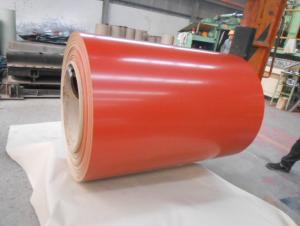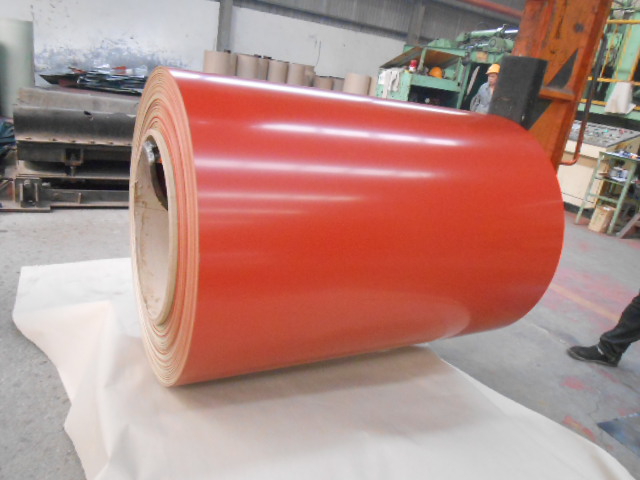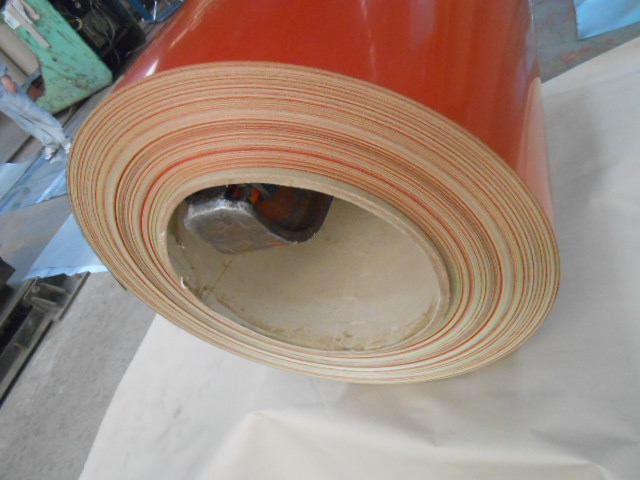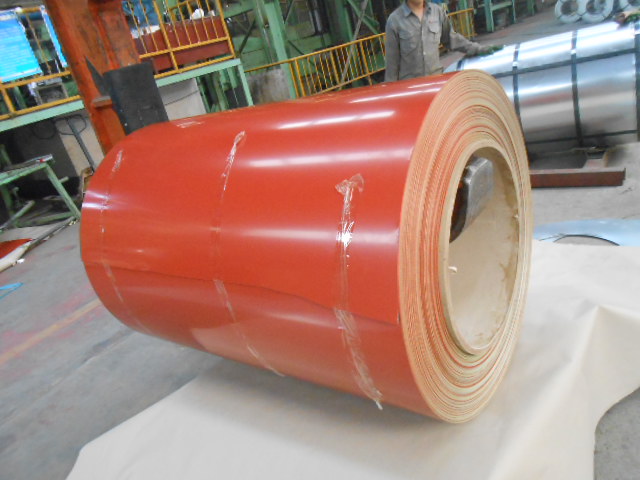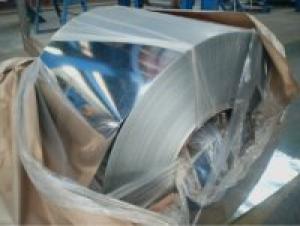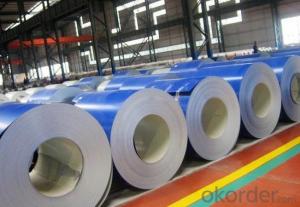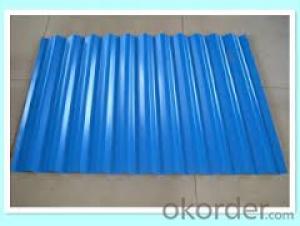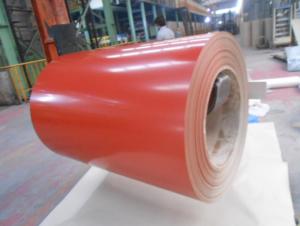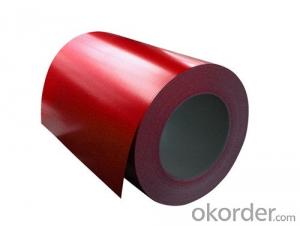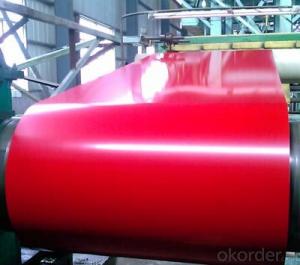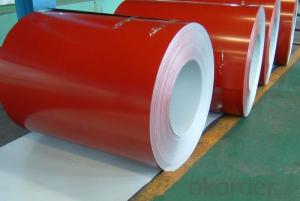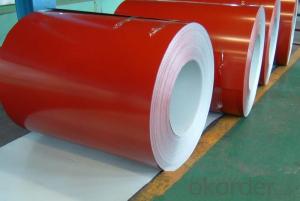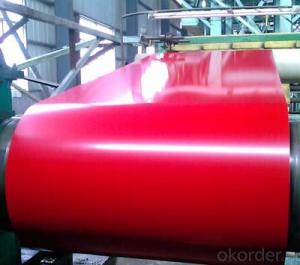Pre-Painted Galvanized/Aluzinc Steel Sheet in Coil Brick Red 0.29mm
- Loading Port:
- Tianjin
- Payment Terms:
- TT OR LC
- Min Order Qty:
- 50 m.t.
- Supply Capability:
- 10000 m.t./month
OKorder Service Pledge
OKorder Financial Service
You Might Also Like
1. Pre-Painted Galvanized/Aluzinc Steel Coil Description:
With GI as base material, after pretreatment (degrease and chemical treatment ) and liquid dope with several layers of color, then after firing and cooling, finally the plate steel is called pre-painted galvanized (aluzinc) steel. Pre-painted galvanized steel is good capable of decoration, molding, corrosion resistance. It generally displays superior workability, durability and weather resistance.
2.Main Features of the Pre-Painted Galvanized/Aluzinc Steel Coil:
• Excellent process capability
• Smooth and flat surface
• Workability, durability
• Excellent heat resistance performance
• High strength
• Good formability
• Good visual effect
3.Pre-Painted Galvanized/Aluzinc Steel Coil Images

4.Pre-Painted Galvanized/Aluzinc Steel Coil Specification
Standard: AISI, ASTM, BS, DIN, GB, JIS
Grade: DX51D, DX52D
Thickness: 0.17-2.0mm
Brand Name: KMRLON
Model Number: coil
Type: Steel Coil
Technique: Cold Rolled
Surface Treatment: Coated
Application: Boiler Plate
Special Use: High-strength Steel Plate
Width: 20-1250mm
Length: customized
commoidty: pre-painted galvanized steel coil
Thickness: 0.13-4.0mm
width: 20-1250mm
zinc coating: 40-180g/m2
printing thickness: top side: 20+/-5 microns, back side: 5-7 microns
color: all RAL color
surface treatment: color coated
coil weight: 4-7 tons
coil ID: 508/610mm
packaging: standard seaworthy packing
5.FAQ of Pre-Painted Galvanized/Aluzinc Steel Coil
1. What’s the application of this product?
Roof, roof structure, surface sheet of balcony, frame of window, etc.
2. What’s the brand of the paint?
We use the best brand of all of the word—AKZO.
3. How about your company?
A world class manufacturer & supplier of castings forging in carbon steel and alloy steel,is one of the large-scale professional investment casting production bases in China,consisting of both casting foundry forging and machining factory. Annually more than 8000 tons Precision casting and forging parts are exported to markets in Europe,America and Japan. OEM casting and forging service available according to customer’s requirements.
4. How to guarantee the quality of the products?
We have established the international advanced quality management system,every link from raw material to final product we have strict quality test;We resolutely put an end to unqualified products flowing into the market. At the same time, we will provide necessary follow-up service assurance.
5. How long can we receive the product after purchase?
Usually within thirty working days after receiving buyer’s advance payment or LC. We will arrange the factory manufacturing as soon as possible. The cargo readiness usually takes 15-25 days, but the shipment will depend on the vessel situation.
- Q: How are steel coils used in the production of steel doors?
- Steel coils are used in the production of steel doors by being processed and shaped into sheets, which are then cut and formed to create the desired door components. These coils provide the raw material for manufacturing steel doors, ensuring their strength, durability, and structural integrity.
- Q: i have searched high and low, but can't find information anywhere!bainitic and pearlitic steels are too in depth, just would like to know if it is hsla steel, or mild steel, or stainless steel etc...thank you in advance :)
- in case you have been to soften rail steel down and pour it into ingots, I doubt anybody could examine to locate this is source besides the fact that a experienced metalurgist could comprehend. whilst the steel grew to become into melted you will desire to toss a handful of previous horseshoes in and alter the composition and no you could comprehend. stable luck such as your challenge, i could decide to comprehend the way it seems.
- Q: What are the different types of steel coil grades and specifications?
- There are several different types of steel coil grades and specifications available in the market. These grades and specifications are designed to meet various industry requirements and applications. Some of the commonly used steel coil grades and specifications are: 1. Hot Rolled Steel Coils: These coils are produced by heating the steel above its recrystallization temperature and then rolling it at a high temperature. Hot rolled steel coils are commonly used in applications where dimensional accuracy and surface finish are not critical. 2. Cold Rolled Steel Coils: Cold rolled steel coils are produced by further processing hot rolled coils through cold reduction mills. This process results in improved surface finish, tighter tolerances, and higher strength compared to hot rolled coils. Cold rolled steel coils are widely used in automotive, construction, and electrical industries. 3. Galvanized Steel Coils: Galvanized steel coils are coated with a layer of zinc to protect them from corrosion. This process, known as galvanization, enhances the durability and longevity of the steel coils. Galvanized steel coils are commonly used in applications such as roofing, fencing, and automotive body parts. 4. Stainless Steel Coils: Stainless steel coils are made from a combination of iron, chromium, and other elements that provide excellent corrosion resistance and high strength. These coils are widely used in industries such as food processing, chemical, and medical, where hygiene and corrosion resistance are critical. 5. High-strength Low-alloy (HSLA) Steel Coils: HSLA steel coils are designed to have higher strength and improved formability compared to conventional carbon steels. These coils are commonly used in structural and transportation applications, where weight reduction and high strength are required. 6. Electrical Steel Coils: Electrical steel coils, also known as silicon steel or transformer steel, are specifically designed for use in electrical equipment such as transformers, motors, and generators. These coils have low core losses and high magnetic permeability, making them ideal for efficient energy transfer. 7. Tool Steel Coils: Tool steel coils are specially formulated to have high hardness, wear resistance, and toughness. These coils are commonly used in the manufacturing of cutting tools, dies, and molds. These are just a few examples of the various types of steel coil grades and specifications available in the market. The selection of the appropriate grade and specification depends on the specific application requirements, such as strength, corrosion resistance, formability, and surface finish.
- Q: i know that steel helmets werent meant to stop bullets, but i was wondering do they have an value whatsoever for stopping bullets, or is that just yet another thing that hollywood made up(like the omaha beach scene in saving private rian)
- Steel helmets were made to stop shrapnel; steel fragments from artillery bursts. They were never meant to stop bullets and most modern rifle rounds will penetrate a steel helmet with ease. The US went to Kevlar helmets for lighter weight and better ballistic protection. Some helmets will deflect handgun rounds. Over half of combat injuries were caused by artillery, so the thinking was to reduce head injuries from shrapnel.
- Q: How many inches of steel can an AK47 using 7.62x39mm rounds penetrate through?
- It can't go through inches. It can go through up to 1/4 of an inch of plate steel but not much more. An M-16 can go through it as well and has less powder behind it but the 7.62X39 is a fat round and it takes a little more to get it through.
- Q: How are steel coils used in the manufacturing of automotive body panels?
- Steel coils are used in the manufacturing of automotive body panels by being processed and shaped into the desired form through techniques like stamping or roll forming. These coils provide the raw material for creating strong and durable body panels, ensuring the vehicle's structural integrity and safety.
- Q: steel structure
- Disadvantages Of Steel
- Q: What are the different types of steel coil edge condition options?
- There are several different types of steel coil edge condition options available, each with its own unique characteristics and advantages. Some of the most common types include: 1. Mill Edge: This is the most basic and common type of steel coil edge condition. It is produced during the hot rolling process and is characterized by a naturally rough and uneven edge. Mill edge coils are typically used for applications where the edge quality is not critical, such as in general fabrication. 2. Slit Edge: Slit edge coils are created by cutting the edges of the steel coil using a slitting machine. This process produces a smoother and more uniform edge compared to mill edge coils. Slit edge coils are often preferred for applications that require a higher level of precision, such as in automotive or electrical industries. 3. Trim Edge: Trim edge coils are similar to slit edge coils but with an additional trimming process to remove any defects or imperfections from the edges. This results in an even smoother and cleaner edge, making trim edge coils ideal for applications where appearance and aesthetic quality are important, such as in architectural or decorative purposes. 4. Deburred Edge: Deburred edge coils undergo a deburring process to remove any sharp or burr-like edges. This is done to ensure safety and prevent injury during handling or processing of the coils. Deburred edge coils are commonly used in industries where worker safety is a priority, such as in construction or manufacturing. 5. Rounded Edge: Rounded edge coils have their edges rounded off to eliminate any sharp corners or edges. This type of edge condition is often used in applications where the coils will come into contact with delicate materials or surfaces, as it helps to prevent scratching or damage. It is important to note that the choice of steel coil edge condition will depend on the specific requirements of the application and the desired outcome. Each type of edge condition offers its own unique benefits, and it is crucial to consider factors such as precision, appearance, safety, and functionality when selecting the appropriate option.
- Q: What is the major disadvantage of hardened steel? Do you think this form of iron would be wear resistant and retain a sharpened edge?
- a disadvantage is the fact that the cold forming capability of this steel
- Q: What are the common coil diameter and weight combinations available for steel coils?
- The common coil diameter and weight combinations available for steel coils vary depending on the specific requirements of the industry or application. However, some commonly available coil diameter ranges include 24 inches to 72 inches, while weight combinations can range from 3,000 pounds to 50,000 pounds or more. These dimensions can be further customized based on the needs of the customer and the capabilities of the steel manufacturer.
Send your message to us
Pre-Painted Galvanized/Aluzinc Steel Sheet in Coil Brick Red 0.29mm
- Loading Port:
- Tianjin
- Payment Terms:
- TT OR LC
- Min Order Qty:
- 50 m.t.
- Supply Capability:
- 10000 m.t./month
OKorder Service Pledge
OKorder Financial Service
Similar products
Hot products
Hot Searches
Related keywords
